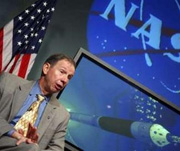 |
| NASA Administrator Michael Griffin
speaks at a news conference at NASA headquarters in Washington
September 19, 2005. | |
It will cost $104 billion over the next decade to
send astronauts back to the moon, NASA's chief said Monday, defending the
price tag
as an investment the nation can afford despite the expense of
Hurricane Katrina.
The new moon exploration plan unveiled by the
space agency will use beefed-up shuttle and Apollo parts and aims to put
people on the moon by 2018.
"There will be a lot more hurricanes and a lot
more other natural disasters to befall
the United States and the world in that time, I hope
none worse than Katrina," NASA Administrator Michael Griffin said at a
news conference.
"But the space program is a long-term investment in our future. We must
deal with our short-term problems while not sacrificing our long-term
investments in our future. When we have a hurricane, we don't cancel the
Air Force. We don't cancel the Navy. And we're not going to cancel NASA."
The $104 billion price tag, leading up to an initial four-person lunar
landing and spread over 13 years, represents 55 percent of what the Apollo
program would cost in today's dollars, Griffin said. Apollo development
spanned eight years, from 1961 to the first manned moon landing in 1969.
The new space vehicle design uses shuttle rocket parts, an Apollo-style
capsule and a lander capable of carrying four people to the moon. The
rockets - there would be two, a small version for people and a heftier one
for cargo - would eclipse the 18-story space shuttle. The larger one, in
fact, would come close to the 36-story Saturn 5 moon rocket.
They would be built from shuttle booster rockets,
fuel tanks and main engines, as well as moon rocket engines. The so-called
crew exploration vehicle perched on top would look very much like an
Apollo capsule, albeit
larger.
The crew exploration vehicle would replace the space shuttle, due to be
retired in 2010, but not before 2012 and possibly as late as 2014
depending on the money available, Griffin said. It could carry as many as
six astronauts back and forth to the international space station.
If all goes well, the first crew would set off for the moon by 2018 -
or 2020 at the latest, the year targeted by President Bush who proposed
such an initiative last year. The same type of vessel could be used, one
day, to transport astronauts to Mars.
The new exploration plan would allow four
astronauts to stay on the moon for a week - twice as long as Apollo
missions. It also would haul considerably more cargo, much of which would
be left on the moon for future crews. In time, lunar stays of up to six
months would be possible.
(Agencies) |
美国宇航局局长本周一宣布,在未来十年间,美国宇航局将出资1040亿美元将宇航员重新送回月球。他还解释说,尽管卡特里娜飓风给美国造成了巨大的损失,美国仍然有能力重金开启新一轮的登月计划。
美国宇航局最新公布的探月计划将使用新一代登月飞船和阿波罗飞船的部分组件,目标是在2018年将人类再次送上月球。
“在此期间,还会有更多飓风和其他各种各样的自然灾害降临美国,乃至整个世界,我希望不会有比卡特里娜更糟糕的了。”美国宇航局局长迈克尔·格里芬在新闻发布会上说。
“但航天计划是一项对未来的长期投资。我们在处理短期问题的同时,也不应牺牲对未来的长期投资。当我们遭遇飓风时,我们没有撤销空军,我们没有放弃海军,因此,我们也不会在这个时候取消国家宇航局。”
这项耗资1040亿美元的登月计划的第一步是将四名宇航员送上月球。按照通货膨胀率折算,这项历时13年之久的重返月球计划其实只相当于当年“阿波罗”登月计划费用的55%,格里芬说。当年,准备“阿波罗”登月计划前后共花费了8年时间,从1961年开始计划,到1969年人类第一次成功地登上月球。
新一代航天工具的设计采用了运载火箭部件、和“阿波罗”号类似的太空舱和一个能够搭载四名探月宇航员的登陆舱。新型运载火箭分为两种不同的类型,体积较小的载人火箭和较笨重的货运火箭。和它们相比,18层楼高的航天飞机都相形见绌。实际上,其中较大的货运火箭的高度接近36层楼高的“土星5”月球火箭。
新型运载火箭将由飞船助推火箭、燃料箱、主发动机以及月球火箭发动机组成。位于新型运载火箭顶端的所谓的宇航员探险飞行器看上去和阿波罗太空舱非常相似,只是更大了一些。
到2010年,航天飞机将退役,被宇航员探险飞行器取代。但这一计划在2012年之前很难实现,可能要推迟到2014年,主要取决于资金问题,格里芬说。宇航员探险飞行器一次最多可以运送6名宇航员往返国际空间站。
如果一切进展顺利,第一批宇航员将于2018年飞向月球,最迟不超过2020年,这是布什总统去年最早提出的想法。将来,这套航天设备还可以用来将宇航员送上火星。
新的探索计划将允许四名宇航员在月球上停留一个星期,比“阿波罗”号在月球停留的时间多出一倍。新的探索计划还将携带更多货物,其中大部分将留在月球上,满足日后登上月球的宇航员的需要。届时,在月球上停留6个月将成为可能。
(中国日报网站 薛晓文译) |
